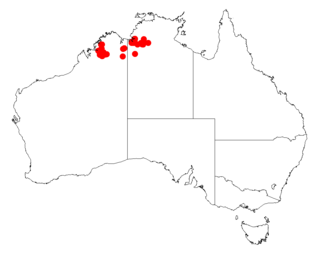
Acacia spondylophylla, commonly known as curry wattle or spine-leaf wattle, is a small, flat topped shrub native to central and western Australia. The leaves, which are arranged on spaced whorls around the stem, have a distinctive curry-like smell.

Acacia palustris, commonly known as needlewood, is a tree or shrub belonging to the genus Acacia and the subgenus Juliflorae that is native to an arid area of western Australia
Acacia synoria is a tree or shrub, also known as goodlands wattle, belonging to the genus Acacia and the subgenus Juliflorae that is endemic to a small area of western Australia.

Acacia tratmaniana is a shrub belonging to the genus Acacia and the subgenus Juliflorae that is endemic to south western Australia.

Acacia inaequiloba is a shrub belonging to the genus Acacia and the subgenus Phyllodineae that is edemic to south western Australia.

Acacia maxwellii is a shrub belonging to the genus Acacia and the subgenus Phyllodineae that is endemic to south western Australia.

Acacia scleroclada is a shrub of the genus Acacia and the subgenus Phyllodineae that is endemic to an area of western Australia.
Acacia amyctica is a shrub of the genus Acacia and the subgenus Plurinerves. It is native to an area in the south of the Goldfields-Esperance region of Western Australia.

Acacia barrettiorum, commonly known as the Barrett's wattle, is a shrub of the genus Acacia and the subgenus Plurinerves. It is native to an area in the Kimberley region of Western Australia.

Acacia caesariata is a shrub of the genus Acacia and the subgenus Plurinerves. It is native to an area in the Wheatbelt region of Western Australia.

Acacia cavealis is a shrub of the genus Acacia and the subgenus Plurinerves that is endemic to an area along the west coast of Australia.

Acacia chapmanii is a shrub of the genus Acacia and the subgenus Plurinerves that is endemic to south western Australia.

Acacia consobrina is a shrub of the genus Acacia and the subgenus Plurinerves that is endemic to south western Australia.

Acacia deflexa is a shrub of the genus Acacia and the subgenus Plurinerves that is endemic to a small area in south western Australia.

Acacia densiflora is a shrub of the genus Acacia and the subgenus Plurinerves that is endemic to an area of south western Australia.

Acacia duriuscula is a shrub or tree of the genus Acacia and the subgenus Plurinerves that is endemic to an area of south western Australia.

Acacia fragilis is a shrub of the genus Acacia and the subgenus Plurinerves that is endemic to south western Australia.

Acacia froggattii is a shrub of the genus Acacia and the subgenus Plurinerves that is endemic to an area in north western Australia

Acacia lineolata, commonly known as dwarf myall, is a shrub of the genus Acacia and the subgenus Plurinerves that is endemic to an area of south western Australia.

Acacia ophiolithica is a shrub of the genus Acacia and the subgenus Plurinerves where it is endemic to a small area along the south west coast of Australia.


















